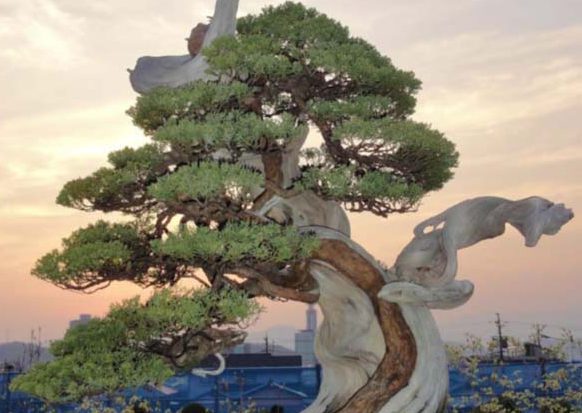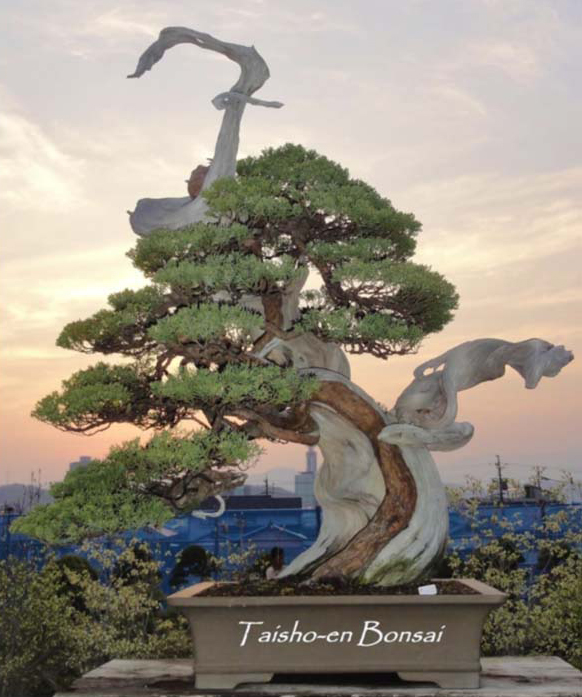

As a bonsai artist and bonsai enthusiast, I remember a bonsai exhibition that had a profound aesthetic effect on me and how I view artists and artistic expression. Below are some of my recollections of this show:
There was an interesting exhibition that ran from Jan. 6 to Feb. 3, 2005, hosted by Fresno City College. This new exhibition was held in the Art Space Gallery, and the exhibition was entitled Installations of Art Responding to Bonsai. As the title of the exhibition implies, this aesthetic display attempted to exhibit the nexus between art and bonsai.
The exhibition was a collaboration among the Fresno City College Visual Art Faculty; invited artists Heather Anderson, Robyn Bates, Jake Elliott, Michael Garcia, Fletcher Niehaus, Robert Ogata, Anne Scheid, Jim Shepard, Howard Statham, Laura West and Kathy Wosika; and bonsai artist Steve da Silva.
I was impressed with their attempt to blend diverse mediums of Western art forms with the various styles of the art of bonsai, which is an Eastern art form from Japan. What really jumped out at me is that this exhibition truly showed the dialectic, the juxtaposition of two opposite, between inorganic, non-living, media and organic, derived from living matter, media. The Western art in this exhibition represented the inorganic, and the trees represented the traditional Eastern organic art of bonsai, translated as trees in pots.
The inorganic was represented by various styles of Western art that included sculpture, painting and mixed media. The organic is represented by bonsai trees trained in one of the following bonsai styles: upright, informal upright, cascade, semi-cascade, slant, clump and broom.
There were the following species of trees styled as bonsai: evergreens (junipers, olive, heavenly bamboo, cedar, schefflera, black pine, boxwood) and deciduous (ginkgo, Japanese zelkova and dawn redwood).
To get the trees into the desired shapes, the trees were wired to train the tree into the image or shape that the bonsai artist wanted the tree to transform into. The main goal of the bonsai artist was for the tree to be designed into an image that reflects a tree in nature. The wire can also be aesthetically viewed as the body of a serpentine dragon coiling and slithering its body around and up the trunk and onto the branches of the tree and mystically shaping the tree into the vision of the artist.
The dialectic of the art presented is that Western art is static, dead and inorganic, whereas the Eastern art is dynamic, alive and organic. The Western art that was exhibited either just hung there or just stood there and will always be non-active whenever it is exhibited. On the other hand, the art of bonsai is active and living.
During the life of a tree that has been trained as a bonsai, from 100 years to 800 years, the tree is pruned yearly and wired when needed in order to maintain the aesthetic shape of the tree. The trees remain outdoors all year but are brought inside on occasion to be exhibited for short periods.
At the reception that was held on Jan. 23, 2005, participants were able to ask questions of the visual artists as to their vision in harmonizing or blending their inorganic Western aesthetic expression to an organic object or tree. They were also able to ask the bonsai artist about the art of bonsai, the styling of the trees, how he blended or harmonized his organic Eastern aesthetic expressions to inorganic aesthetic objects and the history of each tree. Some of the trees exhibited were collected, meaning dug up, from Fresno City College.
The dialectic of the exhibition was balanced from the point of view that both the visual artists and the bonsai artist share the same muse of personal aesthetic creative expression. This desire to create is the mean or nexus that harmonizes the Western and Eastern halves of the inorganic and organic dialectic.
Some artists argue that art is alive. I would counter argue that we (humans) are the ones that make art come alive. The goal of the artist is to create an image that is interpreted by the mind as something that is beautiful or artful.
In Western art, the organic life of a painting or sculpture is dead, whereas in the art of bonsai the tree itself is organic and living and the bonsai artist shapes the tree to aesthetically resemble a tree in nature. The naturalness of the tree is what the viewer perceives as beautiful or as art. Paint and sculpture are just paint and metal, and it is dead or inorganic.
It is the shape or image the artist creates that evokes in the perceiver’s mind, and the perceiver interprets this shape as beauty or what is artful. The perceiver’s mind comes alive organically interpreting the medium—paint, metal or wood, as an artistic expression—but the paint, metal or wood and any mixture of them is inorganic or dead.
The Eastern art of bonsai is organic, and the bonsai artist shapes the tree to resemble nature that makes the viewer’s organic mind view the aesthetic expression like art and therefore artful.
In other words, for Western art, the inorganic is created into a form and that aesthetic form is interpreted by the organic human mind of the viewer as beauty or as art. Bonsai, on the other hand, is organic to begin with and the bonsai artist shapes the tree to resemble nature and the organic mind of the viewer interprets it as beautiful or artful.
To put this argument into a formula: Western Art (WA) is inorganic or dead (I), shaped by an artist (SA), interpreted by an organic human mind (M) to be artful or art (A).
(WA) → (I) → (SA) → (OHM) = (A)
The Eastern art of bonsai (EAB) is organic (O), a tree shaped by a bonsai artist (BA) interpreted by the organic human mind (OHM) to be artful or art.
(EAB) → (O) → (BA) → (OHM) = (A)
The reference point or the mean for art is the artist’s creation and the viewer’s or perceiver’s organic interpretation of what the Western artist or Eastern artist has created as a creation of beauty, a creation that is artful and therefore art.
In a paradoxical way, Western art needs a perceiver because it is created from inorganic materials and shaped into a form that can be interpreted by the organic mind as beauty or art.
The art of bonsai does not really need a perceiver to be labeled art because it is organic and properly maintained and the pruned tree is artful in itself—but a trained perceiver indicates if it is art by how the shape of the tree, shaped by a bonsai artist, based on traditional forms of aesthetic presentations, resembles the trees observed in nature to be beautiful or artful.
Experience the organic art of bonsai through the Clark Bonsai Collection in the ShinZen Japanese Garden at Woodward Park. Also, the Fresno Bonsai Society will exhibit its members’ bonsai trees at the Home and Garden Show at the Fresno Fairgrounds on March 4–6.
